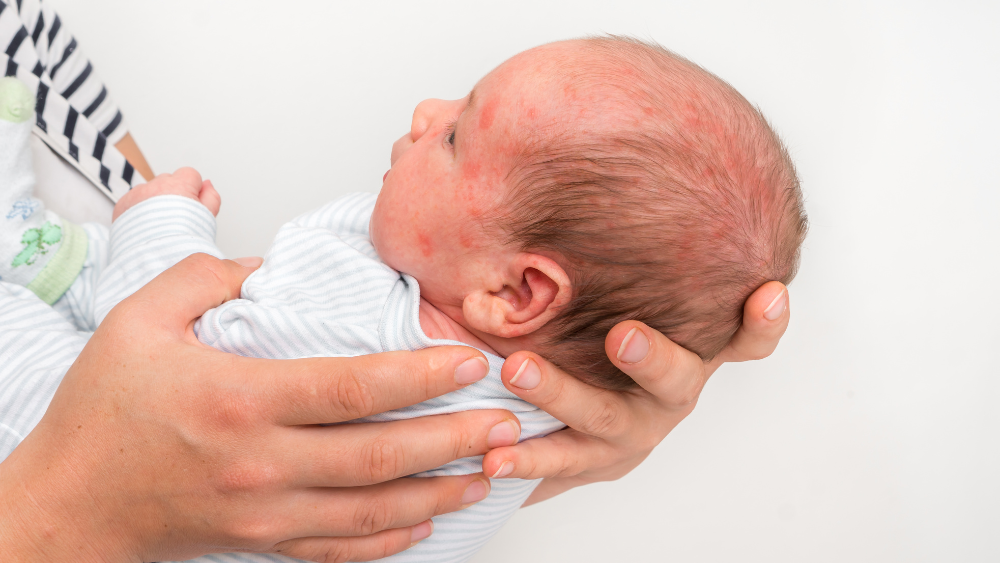Baby and toddler skin rashes are a common part of growing up. The good news? Most rashes are mild, easy to manage, and clear up quickly. Still, it can be worrying for parents when red patches, bumps, or itchy spots suddenly appear on your little one’s delicate skin.
At some point, almost every child will experience a rash. While most aren’t serious and often disappear on their own, others may need a little help — either with home remedies or a doctor’s prescription.
So, what should you do when you notice a new rash? A good rule of thumb: if your child’s rash isn’t causing discomfort, it usually isn’t urgent. But if you’re unsure or want peace of mind, it’s always best to call your pediatrician.
Here’s a guide to the most common types of rashes in babies and toddlers — what causes them, what they look like, and when to seek medical advice.
Common Baby and Toddler Rashes
1. Diaper Rash
What it is: Red, patchy irritation around the nappy area.
Causes: Prolonged contact with urine or stool, yeast or bacterial infections, or even sensitivity to wipes or diapers. Diarrhea can also make it worse.
What it looks like: Bright red, tender skin on the buttocks or genitals. Rashes caused by infection may ooze, crust, or form small pimples.
2. Eczema (Atopic Dermatitis)
What it is: A chronic condition that causes dry, itchy patches that flare up from time to time.
Causes: Genetics, allergies, asthma, and skin sensitivity to irritants like detergents, soaps, fabrics, or foods.
What it looks like: Dry, red, very itchy patches that may become scaly, oozy, or crusty.
3. Bug Bites
What they are: Reactions to mosquito, tick, bee, or other insect bites.
Causes: The body reacts to insect saliva or venom.
What they look like: Small red welts (mosquitoes), painful stings (bees/wasps), or a bull’s-eye rash (ticks).
4. Dry Skin
What it is: Skin that loses moisture and becomes flaky.
Causes: Cold or dry air, long hot baths, harsh soaps, or even teething drool on the face.
What it looks like: Tight, rough, flaky skin that can sometimes become red and itchy.
5. Roseola
What it is: A viral infection, most common between 6 months and 2 years.
Causes: Caused by viruses in the herpes family (not the cold sore type).
What it looks like: High fever followed by a pinkish rash on the torso that spreads outward.
6. Food Allergies
What it is: Immune reactions to foods like milk, eggs, peanuts, or wheat.
Causes: Eating, touching, or sometimes even being near the allergen.
What it looks like: Hives, red itchy rashes, swelling, vomiting, or breathing difficulties in severe cases.
7. Hand, Foot and Mouth Disease
What it is: A viral infection often seen in children under 5.
Causes: Spread through saliva, stool, or contact with blisters.
What it looks like: Flu-like symptoms followed by blister-like rashes in the mouth, on hands, feet, or buttocks.
8. Fifth Disease (Slapped Cheek Syndrome)
What it is: A mild viral illness.
Causes: Caused by parvovirus B19.
What it looks like: Red “slapped cheek” rash that spreads to the body and may appear lacy.
9. Hives
What they are: Raised, red welts on the skin.
Causes: Viral infections, allergies (food, medicine, plants, pollen), or bug bites.
What they look like: Clustered bumps that may itch, sting, or swell.
10. Sunburn
What it is: Overexposure to the sun’s UV rays.
Causes: Time outdoors without enough sun protection.
What it looks like: Pink or red, warm, tender skin. Severe burns may blister.
11. Contact Dermatitis
What it is: An allergic reaction to irritants or allergens.
Causes: Soaps, lotions, detergents, fragrances, nickel in toys or jewelry, or plants like poison ivy.
What it looks like: Red, swollen, itchy rashes that may blister or flake.
12. Poison Ivy (and Oak or Sumac)
What it is: An allergic skin reaction.
Causes: Contact with urushiol oil from the plant.
What it looks like: Red, blistered, very itchy rash, often in a line.
13. Chickenpox
What it is: A viral infection, less common thanks to vaccines.
Causes: Varicella-zoster virus.
What it looks like: Itchy red spots that turn into fluid-filled blisters before scabbing over.
14. Ringworm
What it is: A fungal infection on the skin or scalp.
Causes: Spread from people, pets, or shared items.
What it looks like: Red, scaly patches that may form a circular “ring.”
15. Impetigo
What it is: A contagious bacterial infection.
Causes: Strep or staph bacteria infecting cuts, scrapes, or bug bites.
What it looks like: Red sores that ooze and crust over, often around the mouth or nose.
16. Measles
What it is: A highly contagious viral infection.
Causes: Spread by coughing, sneezing, or touching contaminated surfaces.
What it looks like: Fever, cough, red watery eyes, followed by a red, spreading rash.
17. Scarlet Fever
What it is: A complication of strep throat.
Causes: Bacterial infection (group A strep).
What it looks like: Red, sandpaper-like rash on the body, with a “strawberry tongue.”
18. Lyme Disease
What it is: A bacterial infection spread by ticks.
Causes: Blacklegged tick bites.
What it looks like: Bull’s-eye rash with flu-like symptoms.
When to Call the Doctor
Always check in with your child’s pediatrician if:
- The rash is around the eyes
- There are red, purple, or blue spots
- The rash is blistered, crusty, or oozing
- Your child has a fever, vomiting, breathing issues, or neck stiffness
- You’re unsure or simply need reassurance
The Bottom Line
Rashes in babies and toddlers are usually harmless, but they can look alarming. With a little TLC, most clear up quickly. Trust your instincts, keep your little one comfortable, and reach out to your doctor if you’re worried.

